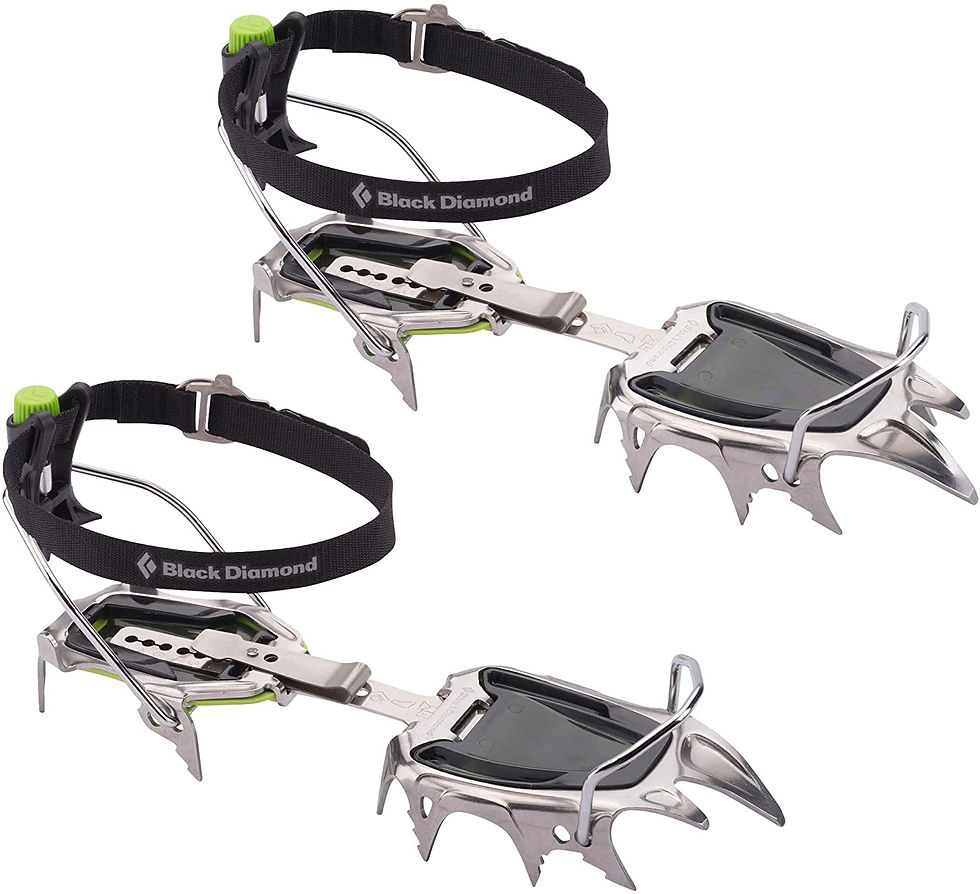The Right Spikes for Winter Hiking
- Dan Oliver
- Dec 18, 2021
- 3 min read
A comprehensive guide to four different types of footwear gear used in winter hiking and when each piece should be used as well as top rated recommendations and where to buy.

Introduction
Like tires of a car in winter, our feet too need chains attached for a better grip hiking in snow and ice conditions. The terrain, snowpack, and elevation all play a roll into the right gear to use and not to use.
In this guide we’ll start at the most basic and work our way upwards to more technical items.

Yaktrax
First up are Yaktrax, the lowest form of traction that you can add to your footwear. The system uses a rubber outside that stretches around your shoe or boot and has a metal wired bottom that provides enhanced traction on snow and ice.
These are great for winter walks along paved or flattened walkways but should not be used in any areas of difficult terrain or elevation.
Yaktrax is the patented name of the gear and can be bought here.

Microspikes
Microspikes have a lot in common to Yaktrax but are made for hiking in parks and backcountry areas. Similar to Yaktrax they use a rubber band to grip the outside of your hiking shoes and adds a set of chains and half-inch spikes to your bottom sole.
Microspikes are a favorite among winter hikers because of the natural feel they have. They perform best on icy terrain with moderate elevation grade and on hard pack snow conditions.
There are many manufacturers of microspikes on the market, the most reputable are Kahtoola which come at a higher price but offer superb quality.
Lower cost can be found here and will perform at a similar quality.

Crampons
Moving up the ladder a step further are crampons, similar to microspikes but with larger spikes. These are best used in tough terrain and steep elevation graded up to ice climbing. The larger spikes and more secure attachment method helps to keep a strong hold where you’re travelling entirely on ice, snow, and vertical rock.
Typically used for experienced hikers and climbers but can also have an advantage over microspikes in proper weather conditions.
Only buy crampons from reputable mountain brands like Black Diamond, Petzl and Katoohla.

Snowshoes
Last but obviously not least are snowshoes. While these stray from the previous three it’s proper to mention here. Snowshoes are best in conditions of snow and deep snowpack. The main purpose is to provide grip and prevent post-holing.
What is post-holing?
Post-holing is when your feet break the layer of snowpack and sink below the surface. When you manage to pull your entire leg out of the hole it’s so deep and wide it resembles that of digging a hole for a fence post, hence the term post-holing.
Not only is post-holing annoying as anything, it also requires a lot of effort, breaks your stride, and breaks the snowpack for others. Having giant holes in the middle of a snowy trail is dangerous and can lead to injuries and annoyed hikers down the line.
By walking on a snowy track in snowshoes you’ll disperse the weight of your feet and stay on top of the snow.
Back to snow shoes…
Snowshoes come in many options but the basics are that they are made to fit any boot using adjustable rubber straps. The bottoms have a crampon and a tail piece that distributes weight. Whereas snowshoes should universally fit all hiking boots, you’ll want to pick the right size depending on your weight.
Options very widely based on planned terrain use but the most popular for climbing mountains are the MSR Lighting Ascent.

Thanks for reading and happy winter hiking!
This post contains affiliate links. As an Amazon Associate affiliate if you use these links to buy something we may earn a commission at no cost to you. Thanks!
©Copyright 2020-2021 Secret Hike
Photography exclusively by Dan Oliver unless otherwise stated and cited. Embedded maps are provided by Embed Google Map (embedgooglemap.net) and map images shown are provided as stated and cited.
DISCLAIMER:
This website is provided for entertainment purposes only, and is not meant to serve as an instructional guide, or present itself as an authority for any of the locations written about. The locations mentioned, written, and photographed herein are nothing more than my personal adventure archive. If you are interested in visiting any locations you should not depend on the information in this website to plan any excursions. You should research a wide variety of informational sources, websites, hiking guide books and maps found elsewhere. Many locations are dangerous and potentially illegal to access which can lead to fines, injury or death even when prepared. I do not encourage anyone to trespass or put themselves or others in way of harm. This website, and therefore its’ owner/author, cannot assume any responsibility for anything you may incur while hiking or exploring any of these locations or anywhere on planet earth. Thank you for viewing!

Comments